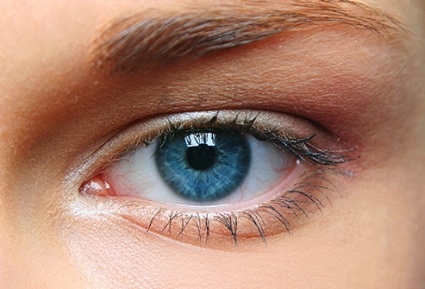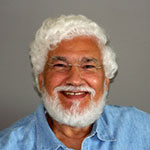November 3, 2019
A cataract operation prompted me to read about the marvel of vision

A picture is worth far more than 1000 words - literally. Science tells us that the human brain devotes 27 per cent of its processing power to visual input, while auditory information takes up only 8 per cent.
Why the huge disparity? It’s because the information we extract from still and moving images is essential to both our survival and enjoyment of life, including appreciating nature’s wonders, the beauty of people around us, and all expressions of art.
We also use remembered visual cues in recalling events, recognizing faces, and connecting imagery with appropriate actions and responses. Similarly, visual information plays a major role in mating and social interactions, not only for we humans, but for many species in the animal world as well.
The process of human sight is very complex. From the time a baby can “see” (fuzzily at first and with few shades of colour), intensive and constant auto training is needed to coordinate the sensory intake of two eyes with the brain as their information processing hub. If this training is interrupted by injury or disease, or hampered by a variety of congenital defects, the brain’s information processing is also hampered.
Medical journals have reported on the case of a man who became blind at only 10 months of age, leaving his brain’s vision-information capacity undeveloped. At the age of 52 he underwent an operation that partially restored his vision. But the results were tragic. His brain and psyche responded with confusion; he became depressed and gave up on life. Three years later he died.
Although humans do not have the sharpest eyes (most birds in the raptor family have far more acute vision) ours are the most sophisticated visual sensors, allowing us to excel in tasks requiring split-second decisions – everything from the routine operation of driving a car to individual competitive tennis, or team sports like hockey, soccer, etc.
Moreover in humans, says Dr. Michael F. Land in The Eye: A Very Short Introduction, “Colour is a construct of the brain, based on information supplied by the eyes. When the region that forms that construct is gone, so is the ability to see, remember, or imagine colour.”
Dr. Land, who is Emeritus Professor of Neurobiology at the University of Sussex (UK), continues, “One might think that the optic nerve would go directly to the brain where a neural version of the image in the eye would be recreated, and that would be what we see. It turns out not to be that simple … The corresponding parts of the image from the two eyes are compared in the cortex and disparities between them detected to produce depth.”
Amazingly, our visual system is not just a product of our genes, but is in fact formed and developed by the external information it receives. For example, humans are remarkably good at recognizing faces, but how we actually do it still remains a scientific mystery.
Scientists have determined, however, that there is far too much information in one visual image to be analyzed fully during a single fixation, or intake – much less to determine whether that image is important to our course of action. Somehow, our optical-neurological processing is able to simultaneously highlight an image’s relevant features and suppress those that are less important. This is called “the attention mechanism.”
When I underwent a recent and successful cataract procedure, I immersed myself in reading about vision in order to ease my pre-operation anxiety. I’d had my cataract condition – in which part of the eye’s lens becomes opaque – since birth, in both eyes. But as with many others in the same situation, it became worse as I aged. And I learned that this operation is more complex than removing cataracts that do not develop until later in life. I also learned that by age 75, about 30 per cent of people have cataracts.
I am thankful the operation was done in one eye at a time. The clouded lens was removed and replaced with a synthetic one. My surgeon was pleased with the results. Before the operation, I told him I am a person of faith and would pray for a good outcome. He smiled and asked that I would also pray for him to do a good job. Of course, I assured him. Now I am waiting for him to operate on the second eye.
In his classic 1968 book Insects in Flight, A glimpse behind the scenes in biophysical research, Dr. Werner Nachtigall wrote, “The bat can construct for itself a precise ‘sound picture’ of its surroundings, and this may be no less clear than the visual picture that many animals can see.”
Nachtigall, a renowned German biologist and now 85 years old, served as director of the Zoologist Institute at the University of Saarlandes.
He continues, “The brain of the bat is able to make instantaneous calculations of the size, distance away, speed and direction of flight of any night-flying insect that happens to pass within the range of the bat’s sonar transmission. Immediately, the bat goes into action like a night fighter, pursues its prey and ends up with its mouth closing neatly over the victim.”
Dr. Almut Kelber, a biologist at Lund University, adds “I did not think that colour vision would be of such significance, rather that birds of prey simply have better visual acuity than humans and that was the reason they detect objects so early and at a great distance. However, colour is of considerable importance.”
A notable exception is Harris’s Hawk. In a biological study, it was shown that if an object is not distinguishable from the background where the colour is approximately the same, it is more difficult for a bird of prey to detect it, whereas a human can do so quite easily. If, on the other hand, the object’s colour contrasts with its background, the Harris’s Hawk can detect it at twice the distance away that humans can.
Falconer Simon Potier notes that this particular species of hawk “… weighs less than one kilo and has small eyes. Nonetheless, it can see many times better than us, even though it is so small and light.”
When I reflect on the marvel of biology that gives humans and so many animals an optical lens of such sophistication and accuracy, I am thankful that we also have the complex ability to surgically correct conditions like cataracts that can threaten the eye’s function. I can now await my second operation with far less anxiety.








